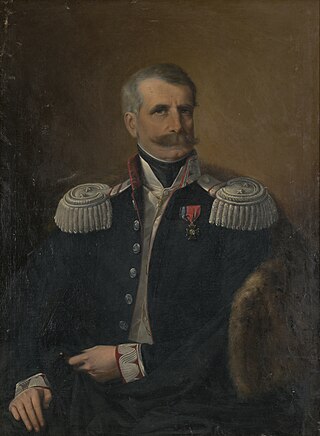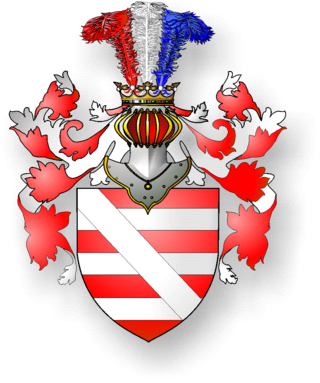Related Research Articles

John II Casimir Vasa was King of Poland and Grand Duke of Lithuania from 1648 to his abdication in 1668 as well as a claimant to the throne of Sweden from 1648 to 1660. He was the first son of Sigismund III Vasa with his second wife Constance of Austria. John Casimir succeeded his older half-brother, Władysław IV Vasa.

Kętrzyn is a town in northeastern Poland with 27,478 inhabitants (2019). It is the capital of Kętrzyn County in the Warmian–Masurian Voivodeship.

Prince Antoni Henryk Radziwiłł was a Polish and Prussian noble, aristocrat, musician, and politician. Initially a hereditary Duke of Nieśwież and Ołyka, as a scion of the Radziwiłł family he also held the honorific title of a Reichsfürst of the Holy Roman Empire. Between 1815 and 1831 he acted as Duke-Governor of the Grand Duchy of Posen, an autonomous province of the Kingdom of Prussia created out of Greater Polish lands annexed in the Partitions of Poland.

Paul Emil von Lettow-Vorbeck, popularly known as the Lion of Africa, was a general in the Imperial German Army and the commander of its forces in the German East Africa campaign. For four years, with a force of about 14,000, he held in check a much larger force of 300,000 British, Indian, Belgian, and Portuguese troops. He is known for never being defeated or captured in battle.

Jan Henryk Dąbrowski was a Polish general and statesman, widely respected after his death for his patriotic attitude, and described as a national hero who spent his whole life restoring the legacy of Poland.

The House of Radziwiłł is a Polish princely family of Lithuanian origin, and one of the most powerful magnate families originating from the Grand Duchy of Lithuania and later also prominent in the Crown of the Kingdom of Poland.

The Inflanty Voivodeship, or Livonian Voivodeship, also known as Polish Livonia, was an administrative division and local government in the Polish–Lithuanian Commonwealth, since it was formed in the 1620s out of the Wenden Voivodeship and lasted until the First Partition of Poland in 1772. The Inflanty Voivodeship was one of the few territories of the Polish–Lithuanian Commonwealth to be ruled jointly by Poland and Lithuania.

The Livonian War (1558–1583) was fought for control of Old Livonia. The Tsardom of Russia faced a varying coalition of the Dano-Norwegian Realm, the Kingdom of Sweden, and the Union of the Grand Duchy of Lithuania and the Kingdom of Poland.

Prince Michał Hieronim Radziwiłł was a Polish nobleman, politician, diplomat and member of the Polish-Lithuanian Radziwiłł family. He was an ordynat of Kleck, Olyka and Niasvizh, Great Sword-bearer of Lithuania from 1771, castellan of Vilnius from 1775, voivode of Vilnius from 1790, starost grabowski, komorowski, kraszewicki, and miksztadzki. He also held a position of Marshal during the Partition Sejm, together with Adam Poniński.
The 1794 Greater Poland uprising was a military insurrection by Poles in Wielkopolska against Kingdom of Prussia which had taken possession of this territory after the 1793 Second Partition of the Polish–Lithuanian Commonwealth.

Greater Poland uprising of 1806 was a Polish military insurrection which occurred in the region of Wielkopolska, also known as Greater Poland, against the occupying Prussian forces after the Partitions of the Polish–Lithuanian Commonwealth (1772–1795).

Baron Dezydery Adam Chłapowski of the Dryja coat of arms was a Polish general, businessman and political activist.

Jan Chrzciciel Henryk Witold Wołodkowicz was a Lithuanian nobleman from the Wołodkowicz family of the Radwan coat of arms. Initially, he served as cavalry captain in the Grand Ducal Lithuanian Army from 1789 to 1794. Joining the French Revolutionary Army in 1796, he rose to the rank of general, which he kept in the Grande Armée. He was also one of Napoleon's Aide-de-camp.

Wincenty Aleksander Korwin Gosiewskide armis Ślepowron – was a Polish nobleman, general, Lithuanian Field Hetman from 1654, Grand Treasurer of Lithuania and Lithuanian Great-Quartermaster since 1652, General of Artillery of Lithuania from 1651, Grand-Master of the Pantry of Lithuania from 1646.

Sypniewski is a Polish surname centered on the Oder region where families bearing this surname are still found today. Sypniewskis can also be found all over the world, particularly in the United States, Brazil, and Germany.

The House of Dönhoff was an old and influential German noble family, which later also became part of the Polish nobility.

The House of Pac or Pacowie was one of the most influential noble families in the Polish–Lithuanian Commonwealth. Numerous high-ranking officials of the Commonwealth came from their ranks. Their coat of arms was Gozdawa.
The Battle of Kisaki was a confrontation between German and South Africa forces near the town of Kisaki, German East Africa, on 7–11 September 1916.

The Prussian Homage is an oil on canvas painting by Polish painter Jan Matejko painted between 1879 and 1882 in Kraków. The painting depicts the "Prussian Homage", a significant political event from the time of the Renaissance in Poland in which Albrecht of Hohenzollern, the Duke of Prussia paid tribute and swore allegiance to King Sigismund I the Old in Kraków's market square on 10 April 1525. Matejko depicted over thirty important figures of the Polish Renaissance period, taking the liberty of including several who were not actually present at the event.

The Plater family is a German noble family originating from Westphalia, whose members first settled in Livonia and later in Lithuania and Poland.
References
- ↑ Chaucer, Geoffrey (1881). The prologue to the Canterbury tales, with notes by E.F. Willoughby . Retrieved 7 January 2022.
- Website of Lettow-Vorbeck family (in German),
- "Polski Słownik Biograficzny" Vol. XVII (the Polish Biographical Dictionary),
- Jan Fenig "Arbor Genealogica - Hypotiposis Vorbekanae" XIII-XVII c. (Lemborg Law Court 1505),
- "Skarbnica pamięci" Ossolineum 1968 in Poland,
- "The Lettows" publ. in USA 1983,
- Polish Armorials: Uruski, Boniecki, Niesiecki, Gajl, Pragert, Ciechanowicz, Dachnowski, Ostrowski, Żernicki-Szeliga, Żychliński and "Polska Encyklopedia Szlachecka" by Starzykoń-Kasprzycki PhD, SJ & rev.Dmowski - Vol.VII,
- "General Jan Henryk Dąbrowski.." by Jan Pachoński, publ. MON (the Polish Ministry of Defense) 1987,
- Siebmacher
- Almanachs of Gotha, incl.: "Ur Adel" and "Royal & Princely Houses" (red cover).